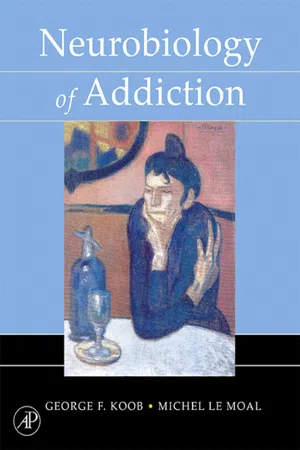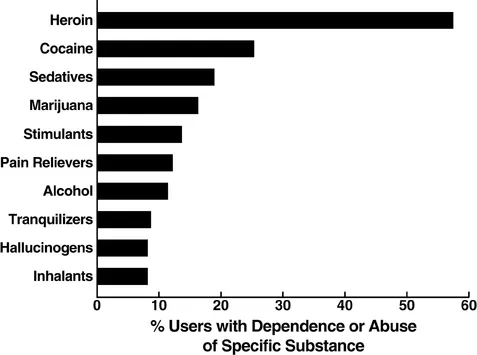
- 504 pages
- English
- ePUB (mobile friendly)
- Available on iOS & Android
eBook - ePub
Neurobiology of Addiction
About this book
Neurobiology of Addiction is conceived as a current survey and synthesis of the most important findings in our understanding of the neurobiological mechanisms of addiction over the past 50 years. The book includes a scholarly introduction, thorough descriptions of animal models of addiction, and separate chapters on the neurobiological mechanisms of addiction for psychostimulants, opioids, alcohol, nicotine and cannabinoids. Key information is provided about the history, sources, and pharmacokinetics and psychopathology of addiction of each drug class, as well as the behavioral and neurobiological mechanism of action for each drug class at the molecular, cellular and neurocircuitry level of analysis. A chapter on neuroimaging and drug addiction provides a synthesis of exciting new data from neuroimaging in human addicts — a unique perspective unavailable from animal studies. The final chapters explore theories of addiction at the neurobiological and neuroadaptational level both from a historical and integrative perspective. The book incorporates diverse finding with an emphasis on integration and synthesis rather than discrepancies or differences in the literature.· Presents a unique perspective on addiction that emphasizes molecular, cellular and neurocircuitry changes in the transition to addiction · Synthesizes diverse findings on the neurobiology of addiction to provide a heuristic framework for future work · Features extensive documentation through numerous original figures and tables that that will be useful for understanding and teaching
Frequently asked questions
Yes, you can cancel anytime from the Subscription tab in your account settings on the Perlego website. Your subscription will stay active until the end of your current billing period. Learn how to cancel your subscription.
No, books cannot be downloaded as external files, such as PDFs, for use outside of Perlego. However, you can download books within the Perlego app for offline reading on mobile or tablet. Learn more here.
Perlego offers two plans: Essential and Complete
- Essential is ideal for learners and professionals who enjoy exploring a wide range of subjects. Access the Essential Library with 800,000+ trusted titles and best-sellers across business, personal growth, and the humanities. Includes unlimited reading time and Standard Read Aloud voice.
- Complete: Perfect for advanced learners and researchers needing full, unrestricted access. Unlock 1.4M+ books across hundreds of subjects, including academic and specialized titles. The Complete Plan also includes advanced features like Premium Read Aloud and Research Assistant.
We are an online textbook subscription service, where you can get access to an entire online library for less than the price of a single book per month. With over 1 million books across 1000+ topics, we’ve got you covered! Learn more here.
Look out for the read-aloud symbol on your next book to see if you can listen to it. The read-aloud tool reads text aloud for you, highlighting the text as it is being read. You can pause it, speed it up and slow it down. Learn more here.
Yes! You can use the Perlego app on both iOS or Android devices to read anytime, anywhere — even offline. Perfect for commutes or when you’re on the go.
Please note we cannot support devices running on iOS 13 and Android 7 or earlier. Learn more about using the app.
Please note we cannot support devices running on iOS 13 and Android 7 or earlier. Learn more about using the app.
Yes, you can access Neurobiology of Addiction by George F. Koob,Michel Le Moal in PDF and/or ePUB format, as well as other popular books in Psychology & Addiction in Psychology. We have over one million books available in our catalogue for you to explore.
Information
CHAPTER 1
What is Addiction?
Publisher Summary
This chapter defines addiction as a chronic relapsing disorder that is characterized by compulsive drug seeking, a loss of control in limiting intake, and the emergence of a negative emotional state when access to the drug is prevented. The definition of addiction is derived from the evolution of the concept of dependence and the nosology of addiction diagnosis. Addiction is ultimately composed of three major stages: (1) binge or intoxication, (2) withdrawal or negative affect, and (3) preoccupation or anticipation. The chapter focuses on the neuroadaptational changes that occur during the addiction cycle, although motivational, psychodynamic, social psychological, and vulnerability factors together contribute to the etiology of addiction. A schematic illustration of a model that proposes a process of incentive salience and accounts for the consequences of drug-induced sensitization is presented in the chapter. The chapter describes a general and theoretical formulation of the homeostatic theory of acute and chronic tolerance and physical dependence along with several other theories presented by various researchers.
DEFINITIONS OF ADDICTION
Drug Use, Drug Abuse, and Drug Addiction
Drug addiction, also known as Substance Dependence (American Psychiatric Association, 1994), is a chronically relapsing disorder that is characterized by (1) compulsion to seek and take the drug, (2) loss of control in limiting intake, and (3) emergence of a negative emotional state (e.g., dysphoria, anxiety, irritability) when access to the drug is prevented (defined here as dependence) (Koob and Le Moal, 1997). The occasional but limited use of an abusable drug clinically is distinct from escalated drug use, loss of control over limiting drug intake, and the emergence of chronic compulsive drug-seeking that characterizes addiction. Modern views have focused on three types of drug use: (1) occasional, controlled or social use, (2) drug abuse or harmful use, and (3) drug addiction. An important goal of current neurobiological research on addiction is to understand the neuropharmacological and neuroadaptive mechanisms within specific neurocircuits that mediate the transition between occasional, controlled drug use and the loss of behavioral control over drug-seeking and drug-taking that defines chronic addiction (Koob and Le Moal, 1997).
The critical nature of the distinction between drug use, abuse and dependence has been illuminated by data showing that approximately 15.6 per cent (29 million) of the U.S. adult population will go on to engage in nonmedical or illicit drug use at some time in their lives, with approximately 3.1 per cent (5.8 million) of the U.S. adult population going on to drug abuse and 2.9 per cent (5.4 million) going on to Substance Dependence on illicit drugs (Grant and Dawson, 1998; Grant et al., 2005). For alcohol, 51 per cent (120 million) of people over the age of 12 were current users, 23 per cent (54 million) engaged in binge drinking, and 7 per cent (16 million) were defined as heavy drinkers. Of these current users, 7.7 per cent (18 million) met the criteria for Substance Abuse or Dependence on Alcohol (see Alcohol chapter). For tobacco, 30 per cent (71.5 million) of people aged 12 and older reported past-month use of a tobacco product. Also, 19 per cent (45 million) of persons in the U.S. smoked every day in the past month. From the 1992 National Comorbidity Survey, 75.6 per cent of 15–54-year-olds ever used tobacco, with 24.1 per cent meeting the criteria for Dependence (Anthony et al., 1994) (see Nicotine chapter).
The number of individuals meeting the criteria for Substance Dependence on a given drug as a function of ever having used the drug varies between drugs. According to data from the 1990–1992 National Comorbidity Survey, the percentage addicted to a given drug, of those people who ever used the drug, decreased in the following order: tobacco > heroin > cocaine > alcohol > marijuana (Anthony et al., 1994) Table 1.1). More recent data derived from the National Household Survey on Drug Abuse (Substance Abuse and Mental Health Services Administration, 2003) showed that the percentage addicted to a given drug, of those who ever used, decreases in the following order: heroin > cocaine > marijuana > alcohol (Fig. 1.1). These more recent data suggest unsettling evidence of an overall trend for a significant increase in Substance Dependence with marijuana (see Cannabinoids chapter).
TABLE 1.1
Estimated Prevalence Among 15–54-Year-Olds of Nonmedical Use and Dependence Among Users (1990–1992) from The National Comorbidity Survey
| Ever used (%) | Prevalence of dependence (%) | Dependence among users (%) | |
| Tobacco | 75.6 | 24.1 | 31.9 |
| Alcohol | 91.5 | 14.1 | 15.4 |
| Illicit Drugs | 51.0 | 7.5 | 14.7 |
| Cannabis | 46.3 | 4.2 | 9.1 |
| Cocaine | 16.2 | 2.7 | 16.7 |
| Stimulants | 15.3 | 1.7 | 11.2 |
| Anxiolytics | 12.7 | 1.2 | 9.2 |
| Analgesics | 9.7 | 0.7 | 7.5 |
| Psychedelics | 10.6 | 0.5 | 4.9 |
| Heroin | 1.5 | 0.4 | 23.1 |
| Inhalants | 6.8 | 0.3 | 3.7 |

The cost to society of drug abuse and drug addiction is prodigious in terms of both direct costs and indirect costs associated with secondary medical events, social problems, and loss of productivity. In the United States alone, it is estimated that illicit drug abuse and addiction cost society $161 billion (Office of National Drug Control Policy, 2001; see also Uhl and Grow, 2004). It is estimated that alcoholism costs society $180 billion per year (Yi et al., 2000), and tobacco addiction $155 billion (Centers for Disease Control and Prevention, 2004). In France, the total cost of drug use is USD 41 billion (including $22 billion for alcohol, $16 billion for tobacco, and nearly $3 billion for illicit drugs) (Kopp and Fenoglio, 2000).
Addiction and Substance Dependence will be used interchangeably throughout this text and will refer to a final stage of a usage process that moves from drug use to abuse to addiction. Drug addiction is a disease and, more precisely, a chronic disease (Meyer, 1996). As such, it can be defined by its diagnosis, etiology, and pathophysiology as a chronic relapsing disorder (Fig. 1.2). The associated medical, social, and occupational difficulties that usually develop during the course of addiction do not disappear after detoxification. Addictive drugs are hypothesized to produce changes in brain pathways that endure long after the person stops taking them. These protracted brain changes and the as...
Table of contents
- Cover image
- Title page
- Table of Contents
- Preface
- Acknowledgments
- Chapter 1: What is Addiction?
- Chapter 2: Animal Models of Drug Addiction
- Chapter 3: Psychostimulants
- Chapter 4: Opioids
- Chapter 5: Alcohol
- Chapter 6: Nicotine
- Chapter 7: Cannabinoids
- Chapter 8: Imaging
- Chapter 9: Neurobiological Theories of Addiction
- Chapter 10: Drug Addiction: Transition from Neuroadaptation to Pathophysiology
- APPENDIX 1: Psychostimulants
- APPENDIX 2: Opioids
- APPENDIX 3: Alcohol
- APPENDIX 4: Nicotine
- APPENDIX 5: Cannabinoids
- Index
